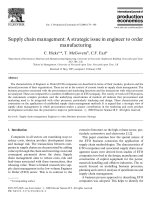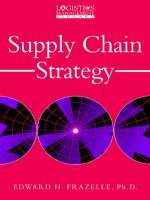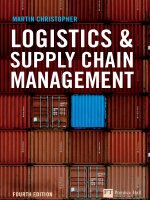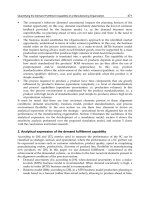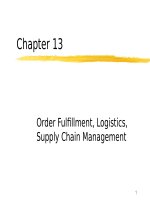Chapter 13: Order Fulfillment, Logistics, Supply Chain Management ppsx
Bạn đang xem bản rút gọn của tài liệu. Xem và tải ngay bản đầy đủ của tài liệu tại đây (176.63 KB, 43 trang )
1
Chapter 13
Order Fulfillment, Logistics,
Supply Chain Management
2
Learning Objectives
1. Understand the role of order fulfillment and back-office
operations in EC
2. Describe the process of order fulfillment
3. Understand the concept of the supply chain, its
importance and management
4. Describe the problems of managing the supply chain
and the use of innovative solutions there
5. Describe the need for integrating information systems of
front office and back office
6. Trace the evolution of software that support activities
along the supply chain and their management
7. Understand the relationship among ERP, SCM and EC.
3
The Y2K Order Fulfillment
Problem
In Dec. 1999 Competition among E-Tailers
increases
Special area: Toys; Big promotions, coupons
Demand: very high, not anticipated
Retailers: were unable to meet demand
Customers: very unhappy
Similar problems in gifts, book, etc.
Also: online retailers has warehousing and
logistics problems
4
Order Fulfillment
Taking orders may be the easiest part
Difficulties in groceries and fresh food
One reason: Customized products
Second: Pull type manufacturing
5
The Pull vs. Push Model
6
Major Concepts
Order fulfillment: Deliver right order on
time
Front office operations: Order taking,
advertisement, CRM
Back office operations: Accounting,
finance, inventor, packaging, logistics
Logistics: Managing the flow of goods,
information and money along the supply
chain
7
The Process of Order
Fulfillment
8
The Steps of Order
Fulfillment
1. Payment Clearance
2. In-stock availability
3. Packaging, shipment
4. Insuring
5. Production (planning,
execution)
6. Plant services
7. Purchasing,
warehousing
8. Demand forecast
9. Accounting, billing
10. Customer contacts
11. Returns (Reverse
logistics)
9
Shipping a Tropical Fish
1. Placing order, payment
2. Transfer order to petstore.com, check stock
3. Use an wholesaler to get the fish
4. Supplier finds fish, ships to wholesalers
5. Wholesalers rushes to Petstore
6. Petstore uses FedEx to ship to customer
with copy of credit card payment
Discussion: What is the contribution of EC?
10
Why Intermediaries?
1. Wholesaler and deliveries in the Petstore
case
2. Wholesalers as an aggregators; between
many sellers and buyers
3. Can a virtual store replace a retailer?
4. Direct sales for large items
5. Example: The Lego Co. case
11
Channel Conflict
Elimination of Intermediary many create a
conflict
Conflict between online and offline
distribution
This may impact order fulfillment and returns
What if a manufacturer sells both wholesale
and retail? (Microsoft)
Customized product by manufacturers: ideal
for direct sale
12
Supply Chain Management
Definition: Flow of material, information,
money, etc. from raw material suppliers
through factories to customers
It includes: organizations, procedures,
people
SCM: Integration of the business
processes along the chain, Planning,
Organizing, control of many activities
Activities: Purchasing, delivery,
packaging, checking, warehousing, etc.
13
Components of the Supply
Chain
14
Components-Description
Upstream
Upstream: Suppliers, their suppliers
(several tiers). From Raw material to the
company
Internal
Internal: All internal process that add
value, conversion to find products
Downstream
Downstream: All activities in distribution
and delivery to end customers
15
Complex-nonlinear Supply
Chain
16
Benefits of SCM
Reduce uncertainty along the chain
Proper inventory levels in the chain
Minimize delays
Eliminate rush (unplanned) activities
Provide superb customer service
Major contributor of success (ever
survival)
17
Global Supply Chain
Can be very long
Possible cross-broader problems
Need information technology support of:
communication and collaboration
Possible delays due to: customs, tax,
translations, politics
18
Problems along the Supply
Chain
Delays in production, distribution etc.
Expensive Inventories
Lack of partners’ coordination
Uncertainties in deliveries
Poor demand forecast
Interference with production
Poor quality
19
More difficulties
Virtual companies do not have logistics
infrastructures
One company is a member of several
supply chain
Conventional warehouses are too
expensive
Need automatic warehouses with robots
as pickers
20
Preliminary Activities
Understand the supply chain (flow charts)
Study internal and external parts
Performance measurement are a must
(Benchmarking)
Multidimension performance analysis
a BPR may be needed
People’s relationships are a must
21
Areas of Opportunities
Manufacturing processes
Warehousing operation
Packaging and delivery
Material inspection/receiving
Inbound and outbound transportation
Reverse logistics (return)
In-plant material handling
Vendor management program
Customer order processing
22
Areas of Opportunities
(cont’d)
Invoicing, auditing and other accounting
activities
Collaboration procedures with partners
Employee training and deployments
Labor scheduling
Use of teams and empowerment of
employees
Automation of processes
Use of software for facilitating all the above
Inventory management and control
23
Using Inventories
An insurance against stock out
Can be in several places
Can be excessive
Can be insufficient
Example: Littlewoods stores; UK
24
Proper SCN
Coordination is needed
Understanding of the causes/problems
Information flow is a key
Communication is important
IT is needed
25
Information Technology for SCM
Links that enable
communication/collaboration
Links the partners
Provide effective and efficient solutions
Extremely important
Need for information sharing
